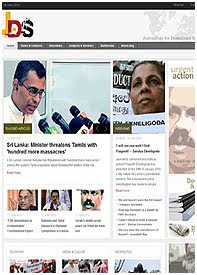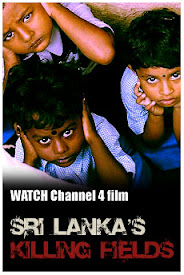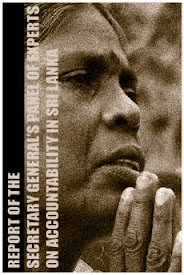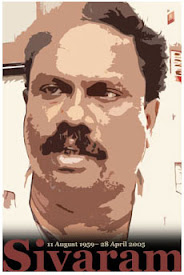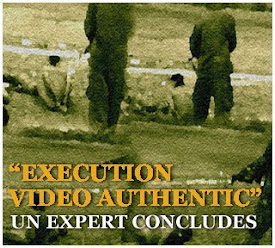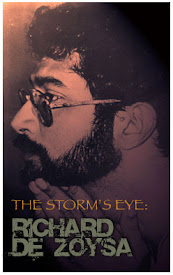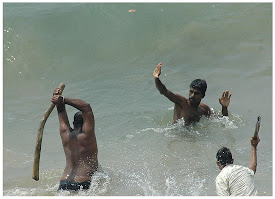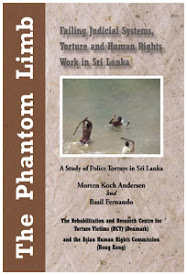
By Charles Haviland | BBC News
.............................................................................................................................................................................................
Some accuse the security forces of abducting the men but police say they are doing their best to find them.
Lalith Kumar Weeraraj and Kugan Muruganathan organised demonstrations by the families of missing people.
They disappeared while organising one such rally in Jaffna, a city central to the civil war which ended in 2009.
A campaign group, Students for Human Rights, handed a letter to the UN's country chief Subinay Nandy asking that the UN Human Rights Council help investigate their disappearance.
Nuwan Bopage, president of Students for Human Rights, said outside the UN building in Colombo: "We have written to all the authorities but so far they have not even responded to us. We still believe they are in military custody."
Supporters have maintained that they believe the security forces secretly abducted them, not least because Jaffna is firmly controlled by the military and because the wife of one of the victims says she later spotted their motorcycle inside a police compound.
The army and police deny holding the men. A police spokesman told the BBC a special investigation was under way.
He said there was no evidence of an abduction but asked people to come forward if they had witnessed such an event.
But campaigners said possible witnesses had been threatened or had gone into hiding, and that they had reported seeing five men taking the activists away in an unmarked white van.
Unsolved disappearances
The father of one of the missing men, Arumugan Weeraraj, said his son only wanted to help people from northern Sri Lanka find their missing family members.
"Please allow me at least to talk to him," he said.
It has emerged that the other missing man, Mr Muruganathan, once belonged to the Tamil Tigers but left the separatist group 10 years ago.
Several other people have disappeared in unexplained circumstances since Mr Weeraraj and Mr Muruganathan went missing.
The UN says there are more than 5,000 cases of unsolved enforced disappearance in Sri Lanka. The rate has dropped since the end of the war but it has since risen again.
Since the two human rights workers disappeared there have been no more demonstrations for the families of missing people.
Janatha Muruganathan, the wife of one of the missing men, said outside the UN in Colombo: "Please give my husband back. We are suffering without him. He has done no wrong to anyone. Please help us find him."
Activists say that during his own campaigns for missing people, Lalith Kumar Weeraraj had visited several places of detention and found there two people who had gone missing.
© BBC
Saturday, January 07, 2012
Appeal to UN over missing Sri Lanka activists
Saturday, January 07, 2012
Tamils in Sri Lanka doubtful about latest LLRC report

By South Asia Wired | Radio Netherlands Worldwide
.............................................................................................................................................................................................
Many Tamils doubt the possibility of an unbiased investigation as long as the military continues to kill, abduct, torture or rape Tamil civilians, they say.
“There are around 40,000 troops in Jaffna alone with a population of 550,000. That is a civilian-military ratio of 1:11," says Ramesh, a Tamil academic from the Tamil-majority city of Jaffna. "It will be a joke to suggest that investigations can happen under this climate. He declined to give his real name because of fear of reprisals.
The government has been saturating Tamil-majority areas with military personnel mostly after the LTTE was defeated in May 2009 and its top leadership was killed. Human rights organisations say the manner of some of the rebels deaths are suspicious and could be classified as war crimes.
While admitting there had been attacks on civilians by government troops, the LLRC report says they were the result of individual misdemeanours and not systematic military policy.
A farce
Anandan, a Tamil who also refused to give his name fearing intimidation, was as dismissive as Ramesh of the thought of an unbiased government investigation. “It is a farce and violation of natural justice to say that the culprit will [investigate] allegations against him or herself.”
Anandan believes that the LLRC’s report is aimed at exonerating the military while pinning all the blame for war crimes on the LTTE. He supports his view by giving an eye witness account of a deposition before the LLRC.
Doctor
Dr. Thurairajan Varatharajah was one of the three government doctors who treated Tamil civilians as the military shelled and bombed areas near their makeshift hospital during the final months of the war. During that time he gave an interview to the international media about civilian casualty numbers.
Later, in July 2009, he and other doctors were arrested. While in police custody however, Dr. Varatharajah made a public statement that he was forced to exaggerate civilian casualties by the LTTE to bring to disrepute the military.
Anandan says that Dr. Varatharajah was not only aware of the bombing of civilian areas, but also of the government denying civilians medicine and food.
However, at the deposition before the LLRC, the commissioners had directed their questions only to establish if the LTTE had artillery positions near Dr. Varatharajah’s hospital, thereby justifying the military shelling and bombing the area, rather than to find out what actually happened.
“They were only interested in incriminating the LTTE not in knowing what happened to the civilians,” Anandan claims.
The biggest threat
The LLRC has recommended to the government to disarm Tamil paramilitary groups to reduce violence. Among the groups mentioned by name is the EPDP that works with the Sri Lanka army in Jaffna and is accused by various organisations, such as the UNHCR, of murder, abduction and intimidating the media.
But to Ramesh and Anandan the recommendation is only pulling the wool over the actual culprits.
“Disarming illegal armed paramilitary groups is necessary and will help normalise things. But the biggest threat today is not these armed groups but the army. Will they cut down on the size of the army?”
Tamils like Anandan and Ramesh are convinced the government will not pursue an honest investigation into war crimes by the military. And the failure to do so will inevitably ruin any chances of genuine reconciliation between Sinhalese and Tamils.
“How can you have reconciliation when the culprits who committed genocide and war crimes are at large? That will only promote further crimes and escalate genocide,” said Anandan.
Tamils who live in the most violent and instable regions of the South Asian island feel that enduring ethnic reconciliation is still far away. They attribute this to what they believe is the continuing impunity enjoyed by the Sri Lankan government.
© RNI
Saturday, January 07, 2012
U.S. applies new strategy in Asia-Pacific region

By Wang Fengfeng | Xinhua
.............................................................................................................................................................................................
"We'll be strengthening our presence in the Asia Pacific, and budget reductions will not come at the expense of this critical region," he said at the Pentagon, accompanied by Secretary of Defense Leon Panetta and Chairman of the Joint Chiefs of Staff Martin Dempsey.
The strategy directs the U.S. military to "rebalance towards the Asia-Pacific region," asking it to rely on existing alliances and expand its networks to include emerging partners.
Maintaining peace, stability, the free flow of commerce, and U.S. influence in this dynamic region will depend in part on an underlying balance of military capability and presence, according to the strategy.
The Middle East is also taken into consideration. The strategy foresees that U.S. defense efforts in the Middle East will be aimed at countering violent extremists and destabilizing threats, while emphasizing Gulf security and preventing the proliferation of ballistic missiles and weapons of mass destruction.
It also says the United States will "continue to place a premium on U.S. and allied military presence in -- and support of -- partner nations in and around this region."
This rebalancing will occur at Europe's expense. The strategy calls for an "evolved" U.S. presence in Europe. It says European countries have become "producers" of security rather than "consumers." Meanwhile, the United States will also maintain engaged with Russia, as well as its Article 5 duty as a NATO member.
"The new strategic guidance nicely balances the demands for continued U.S. global leadership with the reality of fiscal constraints. It correctly reorients U.S. military forces towards Asia, while simultaneously preparing for potential threats from the Middle East," said Dr. Nora Bensahel, deputy director of studies and senior fellow at the Center for a New American Security (CNAS), a Washington think tank.
This rebalancing doesn't mean the United States is giving up its military supremacy.
"Our military will be leaner, but ... agile, flexible and ready for the full range of contingencies and threats," Obama said.
The U.S. military should be able to ensure national security with smaller conventional ground forces, the U.S. president said. He vowed to get rid of "outdated Cold War-era systems" while investing in the capabilities needed for the future, including intelligence, surveillance and reconnaissance, as well as counterterrorism, among others.
Despite fiscal challenges, defense spending will continue to grow albeit at a slower rate, the president said, noting the country still ranks number one in defense spending. Its defense budget "continues to be larger than roughly the next 10 countries combined," Obama said.
The new strategy is likely to shift the emphasis from the Army to the Navy and Air Force as the wars in Afghanistan and Iraq wind down. While the former military focus was fighting and winning two wars simultaneously, experts say that the military will now be focused on winning one war, while spoiling the military aspirations of another adversary in a different region of the world.
Yet speaking at a press conference Thursday, Defense Secretary Panetta said that the United States could still conduct two military operations at the same time.
"The nature of warfare today is ... as you engage, you have to look at how you do it, what forces do you use to be able to confront that enemy, what exactly is involved," Panetta said. "You could face a land war in Korea, and at the same time face threats in the Straits of Hormuz. We have the capability, with this Joint Force, to deal with those kinds of threats, to be able to confront them, and to be able to win. That's what counts."
Budget wars
The strategy foresees some 487 billion U.S. dollars of defense spending reduction in ten years. However, a Congressional "supercommittee" failed to reach a compromise on how to cut 1.2 trillion dollars in spending over the next ten years, meaning if Congress can't find a solution this year, a sequestration method would be triggered, splitting the cuts evenly between civilian and military spending.
Panetta has warned the Department of Defense would face "devastating, automatic, across-the-board cuts that will tear a seam in the nation's defense," should the sequestration take place.
Although Obama urged Congress to reduce the deficit in accordance with the Budget Control Act passed last year, the new strategy didn't mention how this would affect the military, should it come to pass.
Travis Sharp, Bacevich fellow at the CNAS, was critical of Obama's strategy.
"The Obama administration's new strategic guidance assumes that the Department of Defense will absorb 487 billion in cuts to its budget over the next decade. Yet that assumption does not match the current law of the land, sequestration," Sharp said.
He said if sequestration occurs, the Pentagon "will not be able to execute this new guidance." That would further reduce capabilities that provide insurance against uncertainty while preserving capabilities that protect against the most pressing threats facing the nation.
"The new guidance seems to identify ground forces and nuclear weapons as two 'insurance' capabilities that the Department of Defense might cut further if Congress doesn't undo sequestration," Sharp said.
© Xinhua.net
This site is best viewed with firefox

Search
Is this evidence of 'war crimes' in Sri Lanka?
Archive
- ► 2010 (1312)
- ► 2011 (687)
Links
- Reporters Sans Frontières
- Media Legal Defence Initiative
- International Press Institute
- International News Safety Institute
- International Media Support
- International Freedom of Expression eXchange
- International Federation of Journalists
- Committee to Protect Journalists
- Asian Human Rights Commission
- Amnesty International
